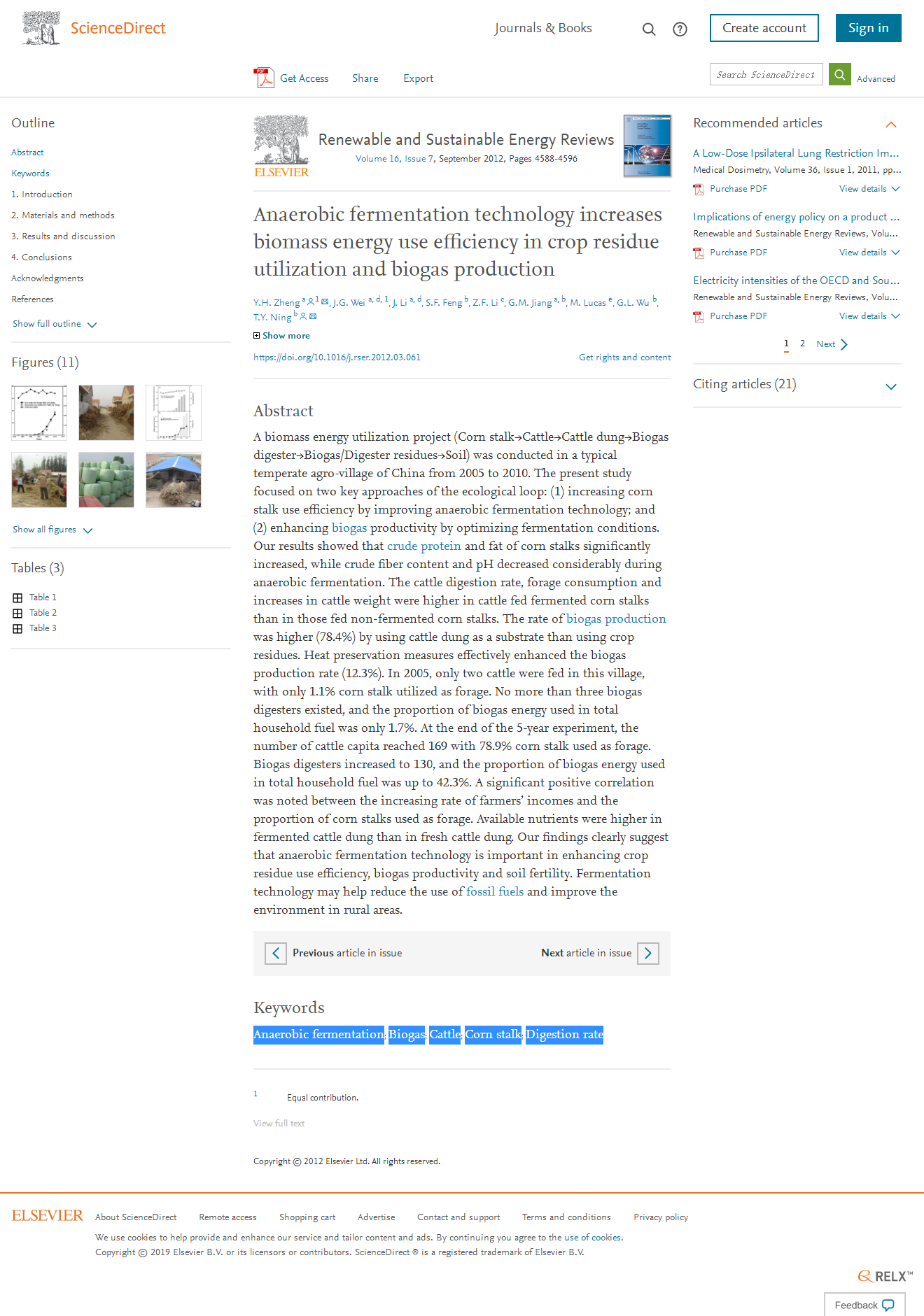博文
厌氧发酵提高了生物质能在农作物秸秆利用和沼气生产中的利用效率
|||
厌氧发酵提高了生物质能在农作物秸秆利用和沼气生产中的利用效率
郑延海、韦继光、李静、冯素飞、李宗奉、蒋高明*、卢卡斯、吴光磊、宁堂原
Energy Reviews, 2012, 16: 4588-4596. (影响因子:11.239)
* 通讯作者
2005-2010年,在中国典型温带农村(山东省平邑县蒋家庄)开展了玉米秸秆→牛→牛粪→沼气池→沼气/沼渣→土壤等生物质能源利用研究。本研究着重探讨生态循环的两个关键途径:(1)通过改进厌氧发酵技术提高玉米秸秆利用效率;(2)优化发酵条件提高沼气产量。结果表明,厌氧发酵过程中玉米秸秆粗蛋白和粗脂肪含量显著增加,粗纤维含量和pH值显著降低,饲喂发酵玉米秸的牛消化率、饲料消耗量和增重率均高于饲喂未发酵玉米秸。以牛粪为基质的沼气生产率高于以农作物秸秆为基质的沼气生产率,达78.4%;冬季保温提高了12.3%沼气产量。2005年,蒋家庄村饲养2头牛,仅1.1%玉米秸秆用作饲料;有沼气池3个,沼气能源占家庭总燃料的比例仅为1.7%。5年试验结束时,以玉米秸为饲料的牛达到169头;沼气池增加到130个;沼气能源占家庭总燃料比重达到42.3%;农民收入增长率与玉米秸秆饲用比例呈显著正相关;发酵牛粪有效养分含量高于新鲜牛粪。厌氧发酵技术对提高作物秸秆利用效率、沼气产量和土壤肥力具有重要意义,有助于减少化石燃料使用,改善农村地区生态环境。
关键词:厌氧发酵,沼气,牛,玉米秸秆,消化率
Anaerobic fermentation technology increases biomass energy use efficiency in crop residue utilization and biogas production.
Renewable and Sustainable Energy Reviews, 2012, 16: 4588-4596. (IF=11.239)
Yanhai Zheng, Jiguang Wei, Jing Li, Sufei Feng, Zongfeng Li, Gaoming Jiang, Mario Lucas, Guanglei Wu, Tangyuan Ning.
A biomass energy utilization project (Corn stalk→Cattle→Cattle dung→Biogas digester→Biogas/Digester residues→Soil) was conducted in a typical temperate agro-village of China from 2005 to 2010. The present study focused on two key approaches of the ecological loop: (1) increasing corn stalk use efficiency by improving anaerobic fermentation technology; and (2) enhancing biogas productivity by optimizing fermentation conditions. Our results showed that crude protein and fat of corn stalks significantly increased, while crude fiber content and pH decreased considerably during anaerobic fermentation. The cattle digestion rate, forage consumption and increases in cattle weight were higher in cattle fed fermented corn stalks than in those fed non-fermented corn stalks. The rate of biogas production was higher (78.4%) by using cattle dung as a substrate than using crop residues. Heat preservation measures effectively enhanced the biogas production rate (12.3%). In 2005, only two cattle were fed in this village, with only 1.1% corn stalk utilized as forage. No more than three biogas digesters existed, and the proportion of biogas energy used in total household fuel was only 1.7%. At the end of the 5-year experiment, the number of cattle capita reached 169 with 78.9% corn stalk used as forage. Biogas digesters increased to 130, and the proportion of biogas energy used in total household fuel was up to 42.3%. A significant positive correlation was noted between the increasing rate of farmers’ incomes and the proportion of corn stalks used as forage. Available nutrients were higher in fermented cattle dung than in fresh cattle dung. Our findings clearly suggest that anaerobic fermentation technology is important in enhancing crop residue use efficiency, biogas productivity and soil fertility. Fermentation technology may help reduce the use of fossil fuels and improve the environment in rural areas.
Keywords: Anaerobic fermentation Biogas Cattle Corn stalk Digestion rate

https://blog.sciencenet.cn/blog-475-1204607.html
上一篇:美国环保署、江苏省农科院专家考察参观弘毅生态农场
下一篇:农村生物质能利用有助于缓解能源危机与全球变暖:以山东省某典型农村为例